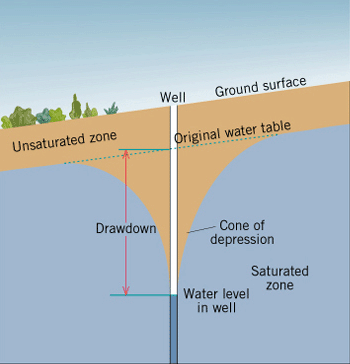In this phase of the water cycle, the water has already condensed and fallen onto a terrestrial environment during precipitation. When liquid water reaches the ground (as opposed to snow or ice) it will either runoff in streams, rivers, or ditches and other storm surge devices, or the water will sink into the ground. If it runs off in a river it will join with a surface reservoir like an ocean or lake. If the water sinks into the ground it is either immediately taken up and used by plants to eventually be transpired or it seeps down into an aquifer.
Aquifers are not large bodies of water in a hollow in the rock like an underground lake (although that can happen, it is considerably rare), rather water is held in the spaces between rocks and soil. Water will flow in these spaces until it reaches a river or stream, a low lying area where it will form a spring, or it will continue onto a lake or ocean. The pictures illustrate drawdown, where wells and pumping stations cause the aquifer around them to lower which will cause the water table to lower. This process combined with lower amounts of rainfall is the reason many local lakes are drying up.
Usually, the process of seeping through the ground acts to filter the water of most impurities it may have picked up on its way down, a reason why we are willing to pay for "spring" water.
If the water fell as snow, then it will accumulate on the surface, unable to seep into the ground or flow to nearby runoff. This will change as soon as the ambient air temperature rises above freezing and the snow melts.
Now that you have learned about accumulatation and aquifers, go to the states of water page for a more in-depth look at water in its three physical states. Be prepared to answer questions about accumulation, aquifers, and the physical states of water.

